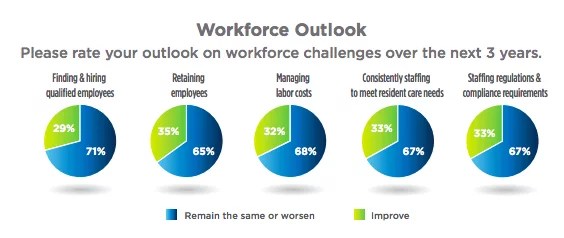Hiring employees is now the top labor challenge for the senior living industry, and unsurprisingly, Covid-19 is a big reason why.
That’s according to a new “Workforce 360” report from OnShift, a company that provides senior living workforce software and services. For its latest report, OnShift heard from more than 2,100 senior living industry professionals, who shared their thoughts on the ongoing labor crisis and how Covid-19 is affecting their staffing practices.
As in the previous report released earlier this year in January, hiring and turnover were respondents’ top two challenges. But the order in which they took importance flipped, with 67% of respondents reporting that finding and hiring qualified job candidates is their top workforce challenge, followed by employee turnover at 57%.
 OnShift Workforce 360 Report
OnShift Workforce 360 ReportOnShift Workforce 360 Report
Much of that has to do with the fact that many frontline workers are under more pressure than ever before as the Covid-19 pandemic drags on, according to Ray Desrochers, president and COO of OnShift.
“[Providers] already can’t find enough people to fill critical needs today, and they’re very concerned about how they’re going to maintain the staff that they have now, which obviously is critical to their existence,” Desrochers told SHN.
As the Covid-19 pandemic worsens across the country, senior living workers are facing new pressure on many fronts. For instance, trepidation is a big problem as the industry confronts a deadly pandemic, with 54% of respondents reporting difficulties managing fear and anxiety among staff. And 80% of respondents said burnout is the most critical challenge facing their employees, with many respondents noting more call-offs and absenteeism (76%) lower motivation and job satisfaction (63%) and an inability to work when needed (52%).
All the while, senior living providers are still facing pressure from other sectors who were actively working to recruit their associates as “gig workers” before the pandemic, such as in retail, package delivery or fast food, Desrochers said.
“[Senior living workers] are being told, ‘Come here, we’ll give you tuition reimbursement, we’ll give you better wages, we’ll give you a situation where you’re not having to deal with the Covid ward,’” Desrochers said.
All of this is pushing senior living providers to more heavily rely on overtime and agency staffing. Among the survey’s respondents, 24% said they often rely on agency staff to cover shifts, while 73% said they often incur overtime. This leads some providers into a downward spiral where they increasingly rely on an ever-shrinking pool of employees.
“They want to rely on those best workers, ultimately, when they can’t find and fill the shifts that are necessary,” Desrochers said. “But that has a ripple effect where it causes higher burnout, and it’s causing them to lose more people.”
Expenses are also up amid the pandemic, with 33% of respondents identifying managing excess labor costs as a top challenge.
And many respondents foresee similarly hard years ahead, with respondents expecting challenges retaining employees (65%), finding qualified employees (71%), managing labor costs (68%) and having enough staff to meet regulatory and compliance requirements (67%) to stay the same or worsen over the next three years.
 OnShift Workforce 360 Report
OnShift Workforce 360 ReportOnShift Workforce 360 Report
That’s why it will be critical for providers to reinvest in their workforce to avoid falling into a negative staffing feedback loop in the months ahead, including in new technology, Desrochers said.
The surveyed providers listed rewards and recognition (51%), hero pay or bonuses (48%) and flexible schedules (41%) among their current choices for employee perks. Respondents also identified resident and family communication (75%), resident engagement (75%), employee scheduling (70%) and employee communication (68%) as high priorities for tech investment.
“Some of the things that are changing in terms of new perks and benefits, and some of the rewards that they’re giving people, they probably are not just just for now,” Desrochers said. “They are probably going to become an important and permanent part of the industry … and I think that’s going to help to attract and retain that next generation of caregivers.”
The post Hiring Displaces Retention as Top Senior Living Labor Challenge appeared first on Senior Housing News.
Source: For the full article please visit Senior Housing News
Be First to Comment